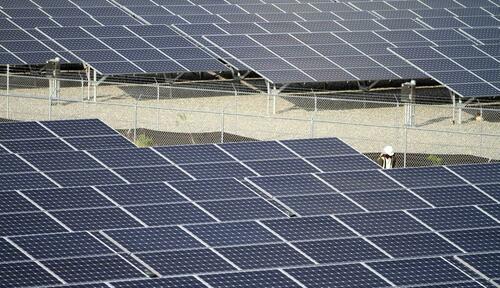Solar is in a Downturn, Similar to Offshore Wind
SolarEdge Technologies shares plunged about two weeks ago, after it warned about decreasing European demand.
Solar Panels Are Much More Carbon-Intensive Than Experts are Willing to Admit
https://www.windtaskforce.org/profiles/blogs/solar-panels-are-more-...
SolarEdge Melts Down After Weak Guidance
https://www.windtaskforce.org/profiles/blogs/wind-solar-implosion-s...
The Great Green Crash – Solar Down 40%
APPENDIX 5
Miscellaneous Articles
World's Largest Offshore Wind System Developer Abandons Two Major US Projects as Wind/Solar Bust Continues
https://www.windtaskforce.org/profiles/blogs/world-s-largest-offsho...
US/UK 66,000 MW OF OFFSHORE WIND BY 2030; AN EXPENSIVE FANTASY
https://www.windtaskforce.org/profiles/blogs/biden-30-000-mw-of-off...
BATTERY SYSTEM CAPITAL COSTS, OPERATING COSTS, ENERGY LOSSES, AND AGING
https://www.windtaskforce.org/profiles/blogs/battery-system-capital...
Regulatory Rebuff Blow to Offshore Wind Projects; Had Asked for Additional $25.35 billion
https://www.windtaskforce.org/profiles/blogs/regulatory-rebuff-blow...
Offshore Wind is an Economic and Environmental Catastrophe
https://www.windtaskforce.org/profiles/blogs/offshore-wind-is-an-ec...
Four NY offshore projects ask for almost 50% price rise
https://www.windtaskforce.org/profiles/blogs/four-ny-offshore-proje...
EV Owners Facing Soaring Insurance Costs in the US and UK
https://www.windtaskforce.org/profiles/blogs/ev-owners-facing-soari...
U.S. Offshore Wind Plans Are Utterly Collapsing
https://www.windtaskforce.org/profiles/blogs/u-s-offshore-wind-plan...
Values Of Used EVs Plummet, As Dealers Stuck With Unsold Cars
https://www.windtaskforce.org/profiles/blogs/values-of-used-evs-plu...
Electric vehicles catch fire after being exposed to saltwater from Hurricane Idalia
https://www.windtaskforce.org/profiles/blogs/electric-vehicles-catc...
The Electric Car Debacle Shows the Top-Down Economics of Net Zero Don’t Add Up
https://www.windtaskforce.org/profiles/blogs/the-electric-car-debac...
Lifetime Performance of World’s First Offshore Wind System in the North Sea
https://www.windtaskforce.org/profiles/blogs/lifetime-performance-o...
Solar Panels Are Much More Carbon-Intensive Than Experts are Willing to Admit
https://www.windtaskforce.org/profiles/blogs/solar-panels-are-more-...
IRENA, a Renewables Proponent, Ignores the Actual Cost Data for Offshore Wind Systems in the UK
https://www.windtaskforce.org/profiles/blogs/irena-a-european-renew...
UK Offshore Wind Projects Threaten to Pull Out of Uneconomical Contracts, unless Subsidies are Increased
https://www.windtaskforce.org/profiles/blogs/uk-offshore-wind-proje...
CO2 IS A LIFE GAS; NO CO2 = NO FLORA AND NO FAUNA
https://www.windtaskforce.org/profiles/blogs/co2-is-a-life-gas-no-c...
AIR SOURCE HEAT PUMPS DO NOT ECONOMICALLY DISPLACE FOSSIL FUEL BTUs IN COLD CLIMATES
https://www.windtaskforce.org/profiles/blogs/air-source-heat-pumps-...
.
IRELAND FUEL AND CO2 REDUCTIONS DUE TO WIND ENERGY LESS THAN CLAIMED
https://www.windtaskforce.org/profiles/blogs/fuel-and-co2-reduction...
APPENDIX 6
According to the IAEA, during the first half of 2023, a total of 407 nuclear reactors are in operation at power plants across the world, with a total capacity at about 370,000 MW
Nuclear was 2546 TWh, or 9.2%, of world electricity production in 2022
https://www.windtaskforce.org/profiles/blogs/batteries-in-new-england
Rosatom, a Russian Company, is building more nuclear reactors than any other country in the world, according to data from the Power Reactor Information System of the International Atomic Energy Agency, IAEA.
The data show, a total of 58 large-scale nuclear power reactors are currently under construction worldwide, of which 23 are being built by Russia.
Nuclear Plants: A typical plant may have up to 4 reactors, usually about 1,200 MW each
In Egypt, 4 reactors, each 1,200 MW = 4,800 MW for $30 billion, or about $6,250/kW, which includes financing by Egypt $5 billion and by Russia $25 billion
That cost is at least 40% less then US/UK/EU
In Turkey, 4 reactors, each 1,200 MW = 4,800 MW for $20 billion, or about $4,200/kW, entirely financed by Russia. The plant will be owned and operated by Rosatom
Rosatom, created in 2007 by combining several Russian companies, usually provides full service during the entire project life, such as training, new fuel bundles, refueling, waste processing and waste storage in Russia, etc., because the various countries likely do not have the required systems and infrastructures
Nuclear vs Wind: Remember, these nuclear plants reliably produce steady electricity, at reasonable cost/kWh, and have near-zero CO2 emissions
They have about 0.90 capacity factors, and last 60 to 80 years
Nuclear do not require counteracting plants. They can be designed to be load-following, as some are in France
Offshore wind systems produce variable, unreliable power, at very high cost/kWh, and near CO2-free
They have about 0.45 CFs, and last 20 to 25 years
They require a fleet of quick-reacting power plants to counteract the up/down wind outputs, on a less-than-minute-by-minute basis, 24/7/365, plus major expansion/reinforcement of electric grids to connect the wind systems to load centers, plus a lot of area.
Major Competitors: Rosatom’s direct competitors, according to PRIS data, are three Chinese companies: CNNC, CSPI and CGN.
They are building 22 reactors, but it should be noted, they are being built primarily inside China, and the Chinese partners are building five of them together with Rosatom.
American and European companies are lagging behind Rosatom, by a wide margin,” Alexander Uvarov, a director at the Atom-info Center and editor-in-chief at the atominfo.ru website, told TASS.
Tripling Nuclear? During COP28 in opulent Dubai, Kerry called for the world to triple CO2-free nuclear, from 370,200 MW to about 1,110,600 MW, by 2050.
https://phys.org/news/2023-12-triple-nuclear-power-cop28.html
Based on past experience in the US and EU, it takes at least 10 years to commission nuclear plants
That means, plants with about 39 reactors must be started each year, for 16 years (2024 to 2040), to fill the pipeline, to commission the final ones by 2050, in addition to those already in the pipeline.
New nuclear: Kerry’s nuclear tripling by 2050, would be 11% of the 2050 world electricity generation. See table
Infrastructures and Manpower: The building of the new nuclear plants would require a major increase in infrastructures and educating and training of personnel, in addition to the cost of the power plants.
https://www.visualcapitalist.com/electricity-sources-by-fuel-in-202....
Existing Nuclear, MW, 2022 |
370200 |
|
Proposed tripling |
3 |
|
Tripled Nuxlear, MW, 2050 |
1110600 |
|
New Nuclear, MW |
740400 |
|
MW/reactor |
1200 |
|
Reactors |
617 |
|
New Reactors, rounded |
620 |
|
Reactors/site |
2 |
|
Sites |
310 |
|
New nuclear production, MWh, 2050 |
5841311760 |
|
Conversion factor |
1000000 |
% |
New nuclear production, TWh, 2050 |
5841 |
11 |
World total production, TWh, 2050 |
53000 |

You need to be a member of Citizens' Task Force on Wind Power - Maine to add comments!
Join Citizens' Task Force on Wind Power - Maine